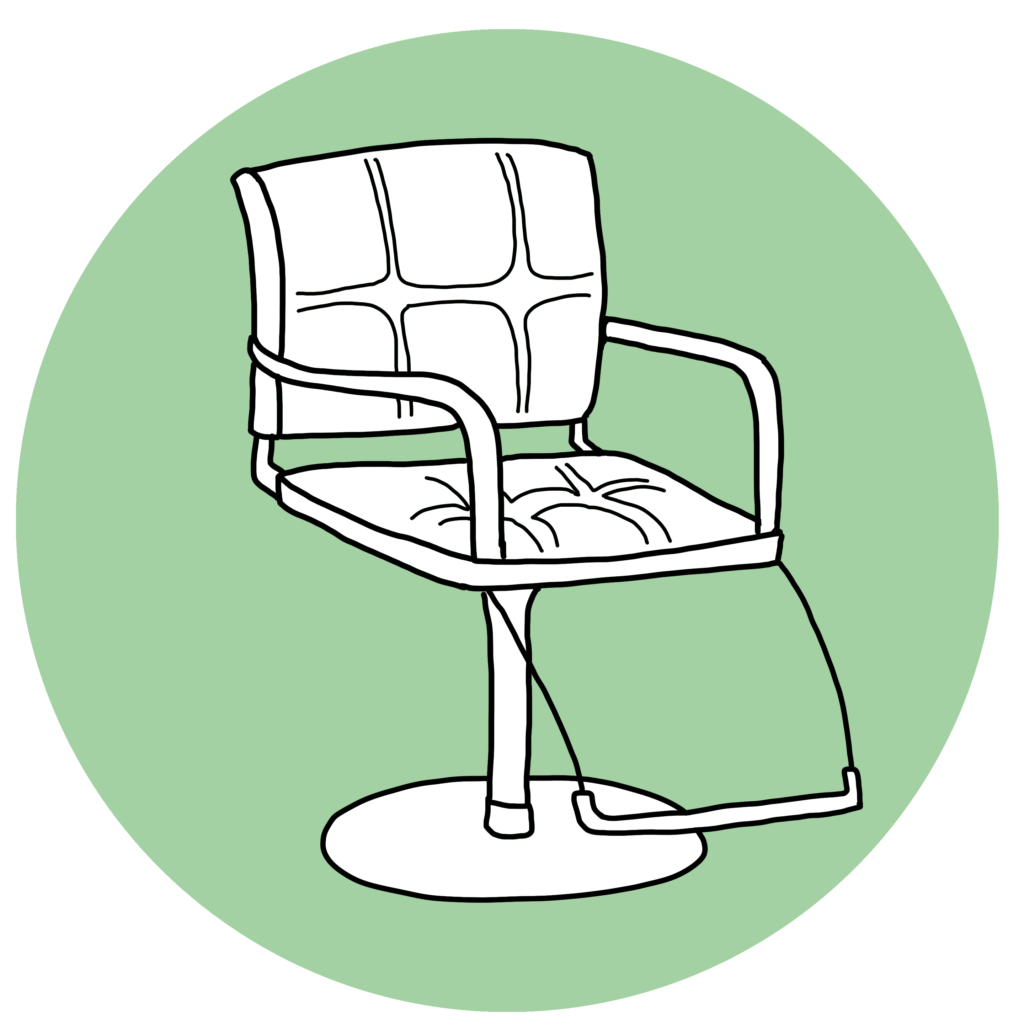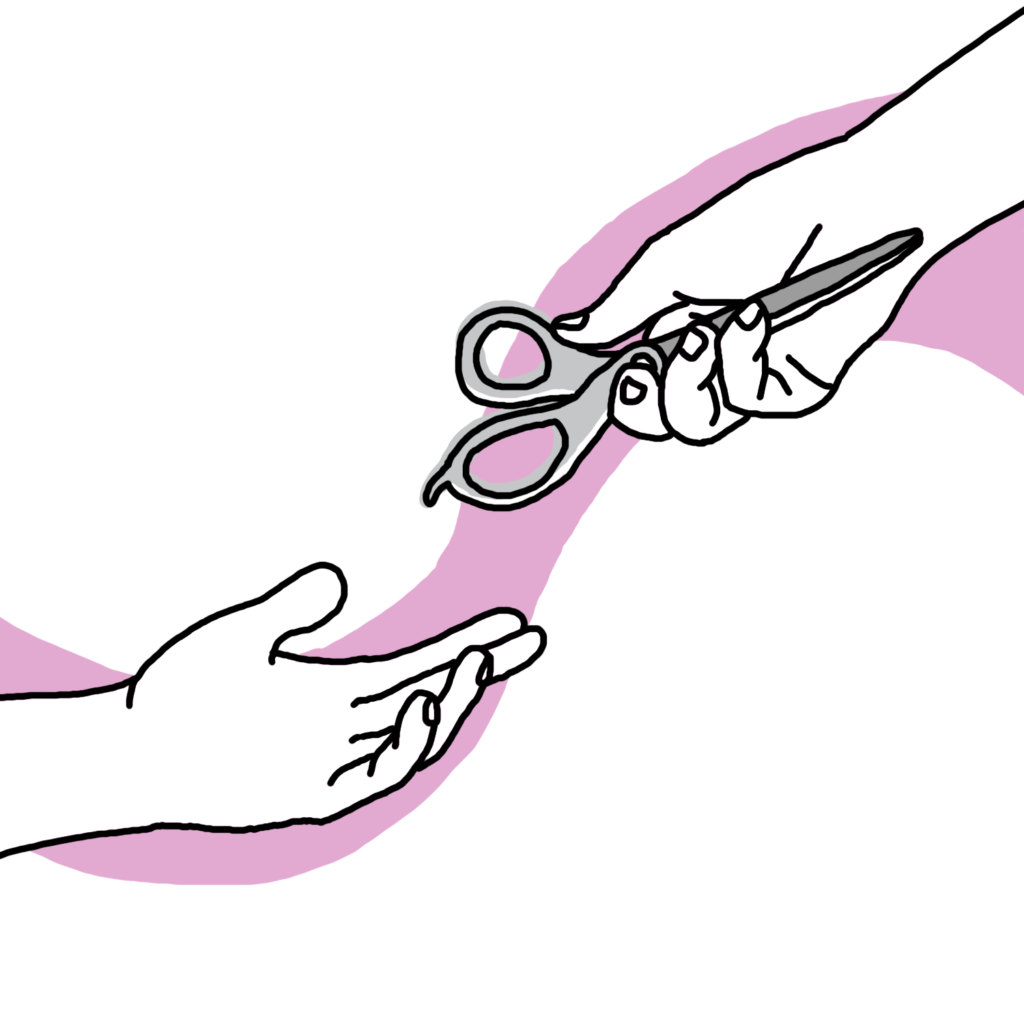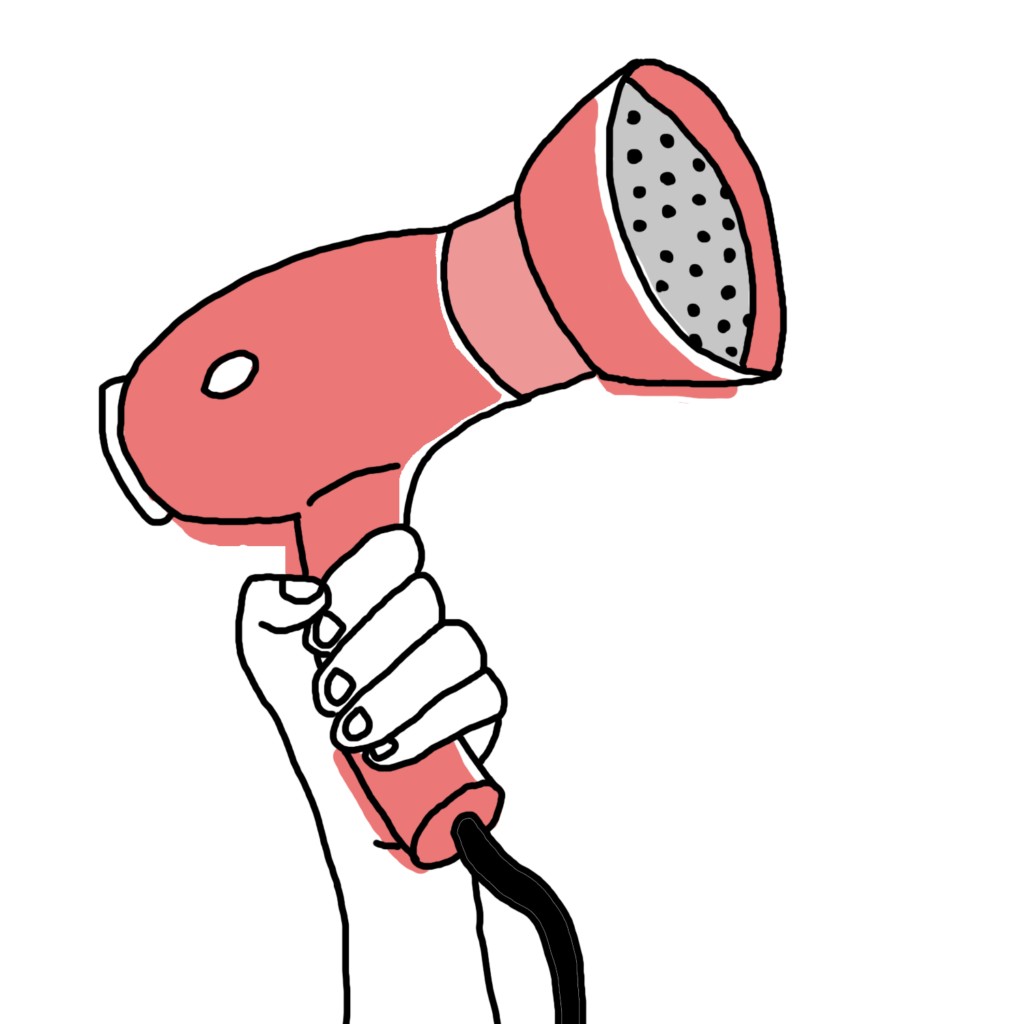5. 13. 2021
Cutting It Out
Selena Hofmann
When you enter a hair salon, can you smell the dyes, bleach, keratin treatments, relaxers, and perm solution? Can you see the misted aerosols sprayed into the air? Can you imagine the toxins in salon workers’ systems after a single day, a week, an entire lifetime? While most people don’t have enough exposure to these chemicals to pose a safety risk, hairstylists are exposed throughout their careers. Regulations in Canada allow cosmetics companies to use terms such as “parfum,” “fragrance,”and “aroma” as catch-alls that conceal the ingredients blended to make a product’s scent, hiding toxins behind the label and calling it a “trade secret.” Common side effects of exposure to such toxins can include lightheadedness, migraines, and contact dermatitis. There is scientific evidence to show that salon work leads to higher risks of cancer. Hairstylists are also at heightened risk of developing carpal tunnel syndrome, tendinitis, chronic pain including shoulder and back pain, trigger finger, osteoarthritis, and muscle spasms. Many of the health-care options that could help (physiotherapy, massage, acupuncture) are not fully covered by private insurance plans. Many salons don’t provide extended health insurance for their employees at all. And “universal” health care in Canada does not routinely cover such costs. This was the state of my industry before the COVID-19 pandemic, which has only made matters worse.
During the first wave of COVID-19 business closures in March 2020, salons were shut down and stylists were out of work. According to a survey conducted by Salon Magazine that polled more than 800 salon workers in Canada in May 2020, almost 20% of those surveyed did not qualify at that time for any government-provided COVID-19 financial support, like the Canada Emergency Response Benefit (CERB). Almost 65% of those polled said they would have difficulty making rent or mortgage payments for their salons that month. Even as more stylists later gained access to CERB, costs such as rent, utilities, and product inventory (some of which would expire during the closures) could not be recovered.
A year later, financial burdens continue to weigh on our industry, and salon workers’ health and safety continue to be neglected in policy. Early this spring, the Ontario government announced plans to reopen hair salons in the Greater Toronto Area, and did reopen salons in other regions of the province, as COVID cases skyrocketed. Hairstylists remained ineligible for vaccination, and deprioritized. Provincial leaders had decided that cops were more “at-risk,” and warranted higher vaccine priority, than salon workers labouring in very close proximity to strangers’ faces all day. Anti-lockdown protesters and politicians made flippant comments about how essential a haircut is for them, while showing absolutely no respect for hairstylists’ health and safety needs.
Those needs have long gone unmet. So why has there not been more collective organizing around them?

Atomized “entrepreneurs”
The working conditions in a salon, as in all workplaces, reflect the capitalist system we live under. That system atomizes workers, and hairstylists are no exception. The physical distance between workers in different workplaces and the pressures of competition isolate stylists from most of our colleagues experiencing similar struggles.
This isolation is deepening through another mode of salon work: the “salon suite.” First popularized in the United States, salon suites are small studios that hairstylists rent from a franchise owner of a complex, which in turn is owned by a larger company such as Phenix, My Salon, or SOLA. The rents that hairstylists pay are mostly passive income for the franchisers, as well as for the larger corporations that have bought up the underlying commercial real estate. These companies attract renters by selling them the dream of “owning their own business.”
The popularity of these salon suites comes down to stylists’ struggle to find satisfactory working conditions in traditional salons. As employees, most hairstylists earn an incredibly low wage compared to many other skilled tradespeople. Our earnings also greatly fluctuate depending on the season, types of services provided, and our willingness to work long hours (which can be detrimental to our bodies in the long term). There are, of course, some salons that have found a way to pay their employees well. But typical conditions of employment in traditional salons make many hairstylists want, or need, to go out alone.
For those who rent a chair or a salon suite, the costs of doing business are downloaded onto the individual worker, who also assumes more risk and responsibility. “Own your own business,” “keep all your profits”: we are sold the idea that we can and should all be entrepreneurs. This propaganda convinces many stylists that it is better to “grind” as an entrepreneur than to collectivize. It is difficult to see ourselves even as employees, let alone as workers. If everyone is a salon owner, in competition with other owners, why would we want to associate in worker-owned collectives, for example?
As hairstylists, we often convince ourselves that our bodies will be strong forever, and that we are most successful when we rely on ourselves alone. But the truth is, we wouldn’t need to work as hard as we do if we harnessed our collective power. We could take a sick day. We could access the preventive medical care we need. We could implement sliding-scale association or union dues: less if you’re an apprentice or junior stylist, more if you’re a senior stylist. We have to dismantle the belief that we are better off on our own. We have to be able to picture ourselves as part of the labour movement.
 Real work, broken system
Real work, broken system
We also need the labour movement to consider workers in the beauty industry to be workers. While some hairstylists hold socialist political views, many more remain non-politicized, and most of us lack training in how to organize together. It has been my experience that some people who espouse a left politics exhibit contempt (conscious or unconscious) for salon, nail, and esthetics workers because of what we represent to those individuals: an industry upholding unjust, discriminatory beauty standards tied to an unjust, discriminatory economic system, and to white supremacy and cis-het patriarchy.
It is true that, consciously or not, hairstylists can play a role in upholding discriminatory standards of beauty, which can hurt people whose hair aesthetics fall outside of the capitalist, patriarchal, white supremacist norm reinforced in predominantly white hairstylist-training institutions. And while salon workers must push against those unfair beauty standards, as much as we can while existing in a society that imposes them, it is unfair to let contempt for those standards bleed into contempt for the workers trying to navigate them, in an industry that’s contemptuous of those workers’ labour as well. We should also notice when such contempt is expressed disproportionately towards traditionally feminized industries.
Sexism shapes what is classified as “real work.” Many jobs that involve essential forms of care for other people – teaching, nursing, caretaking, cleaning – are frequently performed by women and considered to be “women’s work.” There’s often political energy among such workers to professionalize their industries, so their jobs won’t be as easily dismissed in those sexist terms. But this energy doesn’t often extend to tackling the inhumane, unsafe conditions of that professionalized work itself.
It’s clear that hairstyling is widely considered to be “women’s work,” or feminized labour. Canadian government programs like the Apprenticeship Incentive Grant for Women (AIGW), for example, reflect this understanding. The AIGW is a taxable cash grant of $3,000 per year (up to $6,000 in total) available for women who are completing an apprenticeship in a designated trade that has minimal female representation. As I completed my hairstyling apprenticeship, it came as no surprise to me that I would not qualify for this grant. And it may be no coincidence that this trade practiced predominantly by women, and sometimes disparaged as “women’s work,” is also a trade that’s been neglected by the mainstream labour movement.
Bridging the gap between organized labour and hairstylists would be an important step towards addressing the needs of this group of workers. The job of a hairstylist has always looked different from many “union” jobs. No factory to organize in, no shared understanding of ourselves as workers in solidarity with one another. But what hairstylists do have is the ability to talk to people all day, every day. A group of people with lots to gain by organizing their industry and people skills? That sounds valuable to the labour movement!
From isolation to solidarity
The key challenge of organizing hairstylists is one that confronts the labour movement as a whole: how do you organize across distances, across worksites, so every individual stylist can see and feel solidarity with their colleagues, even if they have few or no immediate “coworkers”? As a start, some of us can talk to the coworkers we do have, discussing what feels unfair or out of date about our workplace and the beauty industry at large. Creating relationships of mutual trust and care, a skill central to salon work, is also integral to workplace organizing. As well, one upside of salon suites is that they bring many hairstylists into close proximity with each other. Together we might pool resources and convert a building with salon suites into a worker-owned space, or at least negotiate everyone’s rent down. We could have each others’ backs when some of us choose to inform our clientele about what our labour conditions are like, leveraging those clients’ reach to draw attention to our struggles. We could band together to research and publicize the ingredients in the products we use. We could collectively divest from unsafe hair products, pressuring companies to offer options less harmful to our bodies and the planet. We could team up with other groups of workers who have successfully organized across distances and worksites, such as bike couriers.
We need worker-owned hair salons, able to accommodate a healthy work/life balance and a sustainable work pace. We need a real collective organizing body, not simply a trade regulation body. We need guaranteed access to preventive health care appropriate to our particular occupational hazards, while we also lobby for universal free dental care, vision care, and prescription medication. We need properly fitted protective equipment when using chemicals. We need to stop buying and using products that are slowly killing us, both for the sake of our own health as salon workers and as a broader ecological demand, to protect the planet from chemicals washed down our shampoo basins.
Dreams of organizing hairstylists are not easily realized. There are incredible hurdles: distance, political will, money, power. I’ve seen and heard and experienced cruel exploitation, normalized each time salon workers are told the industry’s standards are unchangeable – that is, if those experiences are discussed at all. Yet, here in Toronto, I’ve also seen connections and shared understandings between hairstylists grow more in the past year than ever before in my working life, as all of us have struggled through long closures of our workplaces. Some of my friends in the industry have noticed themselves literally breathing easier after being off work for an extended time, or seeing added benefits of wearing a mask while at work, as it provides a barrier to hair colour fumes, not just to viruses. Others have been able to sit with their body and notice years of chronic pain they had normalized or ignored and left untreated. Some hairstylists have been able to spend a weekend with their children for the first time in their career. What will we do with these discoveries when we eventually go back to work? Personally, I can’t imagine us returning to the way things were in salons before the pandemic. Can’t and won’t.
Selena Hofmann (she/her) is a hairstylist in Toronto/Tkaronto. For her portfolio and musings on the hair industry: @selenahofmann.
Mirka Loiselle (she/they) is an illustrator and arts educator. Check out their illustrations at mirkaillustrates.com, and on Instagram at @mirkaillustrates.
Related:
- Moments of Vast Possibility Solidarity Winnipeg’s Jesslyn Best and Leslie Ep discuss utopias, popular uprisings, gender and sexual freedom, communist politics, and speculative fiction with M.E. O’Brien and Eman Abdelhadi, the authors of the new book Everything For Everyone: An Oral History of the New York Commune, 2052-2072.
- Protest & Pleasure: A Revolution Led by Sex Workers A conversation with Monica Forrester, Toni-Michelle Williams, and Chanelle Gallant about why trans women of colour sex workers are the leaders we need, lighting the way to revolutionary horizons.
- What We Mean by Community is Our Yearning for Communism M.E. O’Brien on family abolition and the communizing of care as political horizons worth fighting for. A conversation with Midnight Sun editor David Camfield.
- Life-making or Death-making? Susan Ferguson on how the pandemic has laid bare the social reproduction labour that keeps capitalism churning, the fundamental violence of the capitalist system itself, and emerging possibilities for fighting back.
